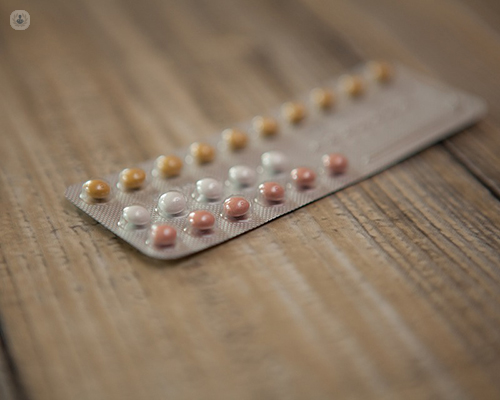What are contraceptive methods?
Contraceptive methods prevent or reduce the possibility of pregnancy. They also help to plan the optimal time to have a child. Currently, there are multiple types of contraceptives administered orally, vaginally, as an injection, by subcutaneous, or physical implant. Common contraceptives include the pill, patch, implant, IUD, IUS and condoms.
Regarding their effectiveness, not all are classified in the same way and will depend on how well they are used for example. In addition, the use of certain contraceptive methods, such as condoms, can prevent the contraction of sexually transmitted infections (STIs). Many forms of contraception do not protect you against STIs so make sure you know which of those do and don't.

Why are they used?
Contraceptive methods are used to prevent unwanted pregnancies. There are couples who want to enjoy sex but do not want to have children. Therefore, it is important to use contraceptive methods to help avoid them and thus be able to plan the best time to have them.
What types of contraception are there?
Among the different contraceptive methods, the most common are:
Barrier methods:
- Condoms - these must be placed very well to avoid pregnancy. You must be careful not to tear it with fingernails, rings or piercings.
- Female condoms
- Diaphragm - It is a latex or silicone plug that the woman inserts into her vagina and thus prevents the entry of sperm to the cervix. Its drawback is that you must wait between 6 and 8 hours to remove it.
Hormonal methods:
- Pill (oral contraceptives) – consists of taking a pill every day. Its effectiveness, if it is well used, is 99.7%. Efficacy can decrease if the person forgets to take it, it is not done at the same time each day or she suffers vomiting or diarrhoea.
- Intrauterine system (IUS) – a plastic device that is inserted into the vagina which releases progesterone to prevent pregnancy. This is a long-lasting method.
- Vaginal ring – a plastic ring placed inside the vagina which gradually releases hormones. It must be changed with each new menstrual cycle.
- Transdermal patch – a "plaster" that contains hormones and placed on the skin. These are changed each week for three weeks out of each month.
- Injection – required every 8-12 weeks depending on the type.
- Implant – this lasts up to three years and works by slowly releasing hormones to prevent pregnancy.
Intrauterine device (IUD) – a plastic and copper device inserted into the vagina which kills sperm and prevents eggs from becoming fertilised.
Permanent methods:
- Tubal ligation – for women who wish to be permanently protected from pregnancy.
- Vasectomy – for men who no longer wish to have children.
What are the side effects of the main contraceptive methods?
Some contraceptive methods can cause side effects such as mood swings, loss of libido, weight gain, and headaches. It is important to choose the best method for yourself. It is not uncommon to try different forms of contraception throughout your reproductive years. Additionally, some people are allergic to latex, so they should be careful when choosing a condom. Some women are unable to have certain hormones, so seek guidance from a GP or specialist.
11-13-2012 11-01-2023Contraceptive methods
Dr Marina Fernando - Obstetrics & gynaecology
Created on: 11-13-2012
Updated on: 11-01-2023
Edited by: Conor Lynch
What are contraceptive methods?
Contraceptive methods prevent or reduce the possibility of pregnancy. They also help to plan the optimal time to have a child. Currently, there are multiple types of contraceptives administered orally, vaginally, as an injection, by subcutaneous, or physical implant. Common contraceptives include the pill, patch, implant, IUD, IUS and condoms.
Regarding their effectiveness, not all are classified in the same way and will depend on how well they are used for example. In addition, the use of certain contraceptive methods, such as condoms, can prevent the contraction of sexually transmitted infections (STIs). Many forms of contraception do not protect you against STIs so make sure you know which of those do and don't.

Why are they used?
Contraceptive methods are used to prevent unwanted pregnancies. There are couples who want to enjoy sex but do not want to have children. Therefore, it is important to use contraceptive methods to help avoid them and thus be able to plan the best time to have them.
What types of contraception are there?
Among the different contraceptive methods, the most common are:
Barrier methods:
- Condoms - these must be placed very well to avoid pregnancy. You must be careful not to tear it with fingernails, rings or piercings.
- Female condoms
- Diaphragm - It is a latex or silicone plug that the woman inserts into her vagina and thus prevents the entry of sperm to the cervix. Its drawback is that you must wait between 6 and 8 hours to remove it.
Hormonal methods:
- Pill (oral contraceptives) – consists of taking a pill every day. Its effectiveness, if it is well used, is 99.7%. Efficacy can decrease if the person forgets to take it, it is not done at the same time each day or she suffers vomiting or diarrhoea.
- Intrauterine system (IUS) – a plastic device that is inserted into the vagina which releases progesterone to prevent pregnancy. This is a long-lasting method.
- Vaginal ring – a plastic ring placed inside the vagina which gradually releases hormones. It must be changed with each new menstrual cycle.
- Transdermal patch – a "plaster" that contains hormones and placed on the skin. These are changed each week for three weeks out of each month.
- Injection – required every 8-12 weeks depending on the type.
- Implant – this lasts up to three years and works by slowly releasing hormones to prevent pregnancy.
Intrauterine device (IUD) – a plastic and copper device inserted into the vagina which kills sperm and prevents eggs from becoming fertilised.
Permanent methods:
- Tubal ligation – for women who wish to be permanently protected from pregnancy.
- Vasectomy – for men who no longer wish to have children.
What are the side effects of the main contraceptive methods?
Some contraceptive methods can cause side effects such as mood swings, loss of libido, weight gain, and headaches. It is important to choose the best method for yourself. It is not uncommon to try different forms of contraception throughout your reproductive years. Additionally, some people are allergic to latex, so they should be careful when choosing a condom. Some women are unable to have certain hormones, so seek guidance from a GP or specialist.


Sex after giving birth: how long should I wait?
By Dr Shazia Malik
2024-11-21
Having a baby is a life-changing experience that impacts a woman physically, mentally and emotionally. For some women, getting back to their pre-birth routine is a somewhat straightforward experience, while for others, it is more of a challenge. One factor that women may struggle with after giving birth is engaging in sexual intercourse, often wondering when is the right time to do so. Distinguished consultant obstetrician and gynaecologist Dr Shazia Malik is here to answer any doubts you may have. See more


Surprise second pregnancies: How can breastfeeding mask the telltale signs that you are expecting?
By Dr Shazia Malik
2024-11-21
As revered consultant obstetrician and gynaecologist Dr Shazia Malik explains in this informative article, surprise second pregnancies can occur for various reasons. The leading specialist also shares her expert insight on choosing contraception after giving birth. See more


Considering HRT… what do I need to know?
By Mr Michael Magro
2024-11-21
Hormone replacement therapy (HRT) is a safe treatment for women, which is aimed at improving menopausal symptoms. Menopause usually occurs between the ages of 45-55. However, symptoms can start before periods stop (perimenopause), and if the menopause occurs before the age of 40 years, it's known as premature ovarian insufficiency (POI). Leading London gynaecologist Mr Michael Magro goes into expert detail about this valuable treatment in this informative article, considering its benefits, risks and the different types, among other important points. See more


Is it safe to take the pill after turning 40?
By Dr Hana Patel
2024-11-20
Taking the pill after you turn 40 can have certain side effects or complications. In her latest article, renowned GP Dr Hana Patel explains these dangers in detail and outlines how you can stay safe while using contraception after turning 40. See more
Experts in Contraceptive methods
-
Miss Christine Robinson
Obstetrics & gynaecologyExpert in:
- Contraceptive methods
- Hormone replacement therapy (HRT)
- Menopause
- Intrauterine device (IUD)
- Polycystic ovary syndrome (PCOS)
- Premenstrual syndrome (PMS)
-
Miss Elaine Scott
Obstetrics & gynaecologyExpert in:
- Miscarriage
- Childbirth
- Caesarean
- Contraceptive methods
- Menstrual disorders
- Hormone replacement therapy (HRT)
-
Dr Amelia Davison
Obstetrics & gynaecologyExpert in:
- Miscarriage
- Heavy periods
- Contraceptive methods
- Menstrual disorders
- Hysteroscopy
- Laparoscopy
-
Dr Marina Fernando
Obstetrics & gynaecologyExpert in:
- Hysteroscopy
- Ultrasound
- Contraceptive methods
- Postmenopausal bleeding
- Amenorrhoea
- Menstrual disorders
-
Dr Deepa Janga
Obstetrics & gynaecologyExpert in:
- Ultrasound
- Menstrual disorders
- Contraceptive methods
- Gynecological pathologies
- Miscarriage
- Postmenopausal bleeding
- See all

House of Health
House of Health
90 Pope St, Birmingham, B1 3AG
No existe teléfono en el centro.
By using the telephone number provided by TOP DOCTORS, you automatically agree to let us use your phone number for statistical and commercial purposes. For further information, read our Privacy Policy
Top Doctors

St Erme Medical
St Erme Medical
St Erme Medical St Erme Truro TR4 9BW
No existe teléfono en el centro.
By using the telephone number provided by TOP DOCTORS, you automatically agree to let us use your phone number for statistical and commercial purposes. For further information, read our Privacy Policy
Top Doctors

London Gynaecology- The City of London
London Gynaecology- The City of London
15 Austin Friars, London EC2N 2HE, United Kingdom
No existe teléfono en el centro.
By using the telephone number provided by TOP DOCTORS, you automatically agree to let us use your phone number for statistical and commercial purposes. For further information, read our Privacy Policy
Top Doctors
-
House of Health
90 Pope St, Birmingham, B1 3AG, BirminghamExpert in:
- Anxiety
- Plastic surgery, reconstructive and aesthetics
- Obstetrics and Gynaecology
- Women’s health
- Menopause
- Sexual health
-
St Erme Medical
St Erme Medical St Erme Truro TR4 9BW, TruroExpert in:
- Blood test
- Women’s health
- General practice
- Menopause
- Health check up
- Sexual health
-
London Gynaecology- The City of London
15 Austin Friars, London EC2N 2HE, United Kingdom, Central LondonExpert in:
- Miscarriage
- Cancer screening clinic
- Ultrasound
- Pregnancy
- Endometriosis
- Fibroids
- See all
- Most viewed diseases, medical tests, and treatments
- Menopause support
- Pelvic ultrasound
- Complex endometriosis
- Migraine
- Maternal mental health
- Joint pain
- Nutrition
- Weight loss injections
- Nipple discharge
- Minimal access surgery (keyhole surgery)







